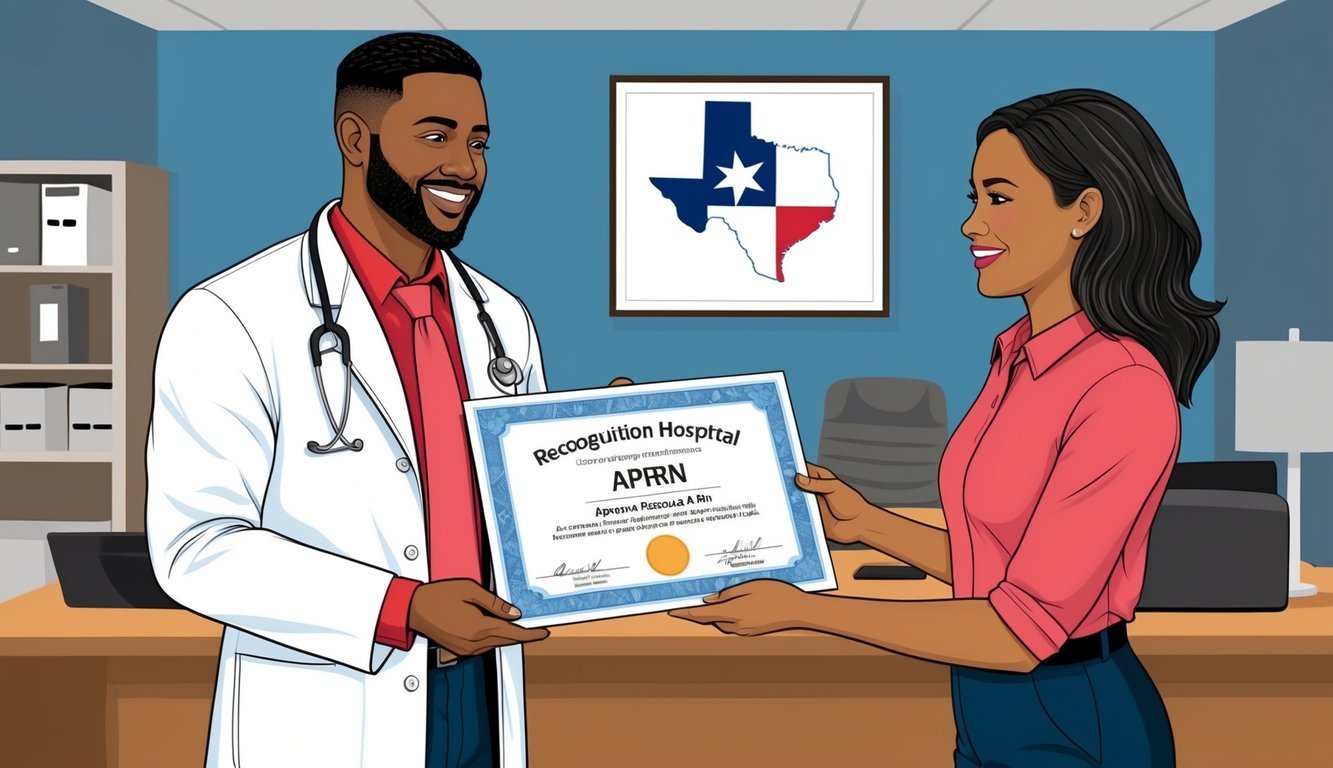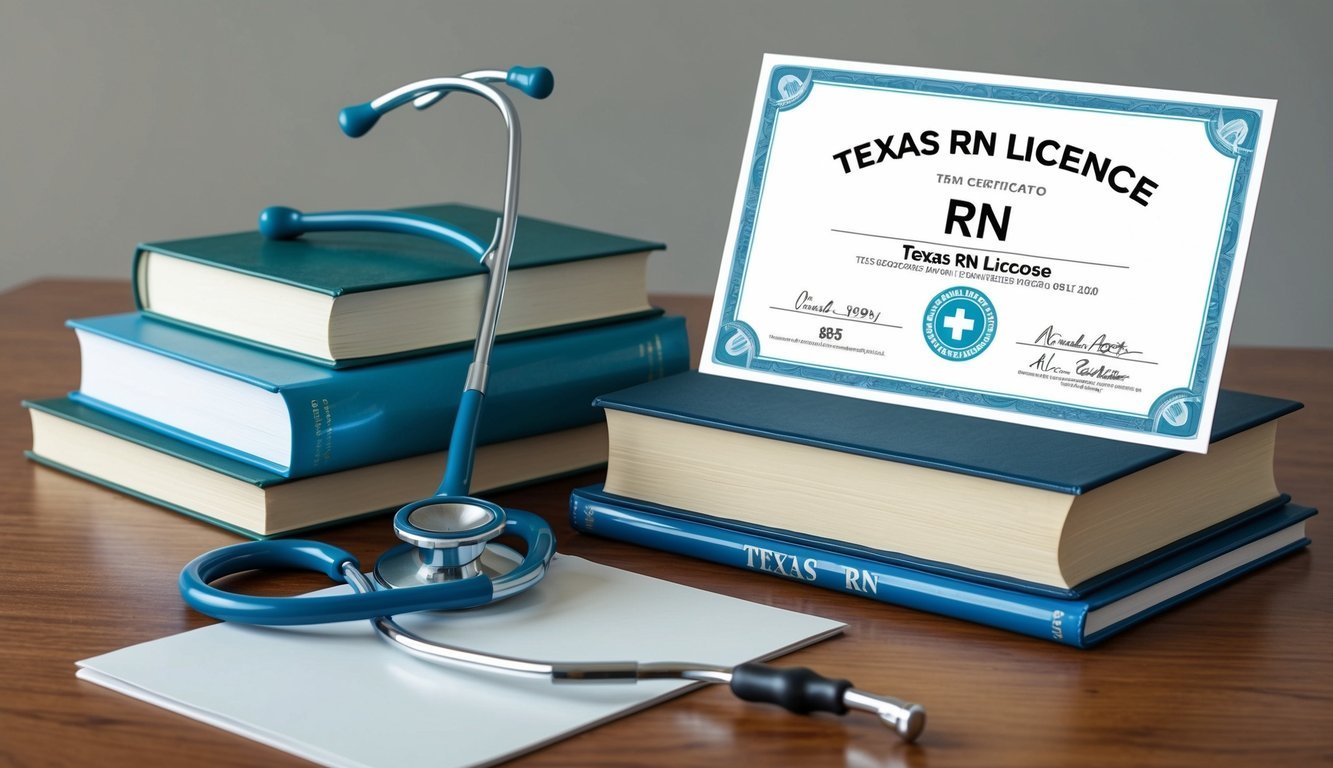Becoming a registered nurse (RN) in Texas involves understanding the specific requirements set by the Texas Board of Nursing.
To practice as a registered nurse in Texas, you need to complete an approved nursing program, pass the NCLEX-RN exam, and obtain a Texas RN license.
This process can seem overwhelming, but knowing the steps can make it much easier.
In Texas, the nursing community is large and diverse, with numerous resources available to support you throughout your journey.
Whether you are just starting out or looking to renew your license, the state provides guidance and information to navigate these processes efficiently.
As you explore this topic, you’ll discover essential details about licensing, renewal, and additional opportunities in nursing.
Understanding the licensing process can pave the way for a rewarding career in nursing.
With this article, you will gain insights into how to successfully obtain and maintain your RN license in Texas.
Key Takeaways
- You need to complete an approved program and pass the NCLEX-RN exam to get your Texas RN license.
- License renewal requires meeting continuing education and practice hour requirements.
- Texas offers resources for nurses seeking endorsement or advanced practice recognition.
Overview of RN Licensing in Texas

In Texas, obtaining a Registered Nurse (RN) license is a critical process governed by specific rules and regulations.
You will need to navigate the roles of the Texas Board of Nursing and understand the Nursing Practice Act to achieve your licensing goals.
Texas Board of Nursing Role
The Texas Board of Nursing (BON) is the authority that oversees the nursing profession in Texas.
Its main responsibilities include protecting the public and ensuring that nurses meet strict educational and professional standards.
The BON issues RN licenses to qualified individuals, having approved over 200 nursing education programs across the state.
The board also manages license renewals, which require continuing education contact hours.
For more information about the BON and its services, you can visit the Texas Board of Nursing website.
The Nursing Practice Act
The Nursing Practice Act (NPA) outlines the legal framework for nursing in Texas.
This act defines the scope of nursing practice and sets the standards for education and licensure.
You must comply with the NPA to maintain your RN license.
Key points include:
- Requirements for licensure by examination or endorsement.
- Procedures for license renewal, including continuing education.
- Disciplinary actions for violations or unsafe practices.
Understanding the NPA is essential to ensure you practice nursing safely and legally.
For complete details, refer to the Nursing Practice Act.
Initial RN Licensure Process

The initial RN licensure process includes steps that ensure you meet the necessary requirements to practice as a registered nurse in Texas.
This process involves licensure by examination, understanding eligibility requirements, and registering for the examination.
Licensure by Examination
To obtain your nursing license in Texas, you must go through licensure by examination.
This means you need to take and pass the NCLEX-RN exam, which tests your knowledge and skills as a nurse.
You will first need to apply for licensure through the Texas Board of Nursing.
As part of this process, create an account on the Texas Nurse Portal.
After your application is processed and approved, you will receive an Authorization to Test (ATT) that allows you to register for the NCLEX-RN exam.
Eligibility Requirements
To be eligible for the NCLEX-RN exam, you must fulfill several requirements.
These include:
- Education: You must have graduated from an accredited nursing program.
- Age: You must be at least 18 years old.
- Criminal History: You will need to disclose any criminal history. A criminal background check and fingerprinting are mandatory.
Be prepared to provide transcripts and other documents to prove your eligibility.
Additional information can be obtained from the Texas Board of Nursing.
Examination Registration
Once you confirm your eligibility, you can register for the NCLEX-RN exam.
Start by completing the NCLEX application available through the nurse portal.
After creating an account, follow these steps:
- Fill out the application form.
- Pay the exam fee.
- Choose your preferred test date and location.
Once registered, you will receive your ATT via email.
This document is essential for scheduling your exam.
Be sure to keep it accessible as it contains important instructions and dates.
RN License Renewal and Maintenance
Maintaining your Registered Nurse (RN) license in Texas involves understanding the requirements for renewal and the necessity of continuing education.
Staying informed about name changes and other critical information is also essential for keeping your license active.
Renewal Requirements
In Texas, nursing licenses are valid for two years.
To renew your RN license, you must log into the Texas Nurse Portal and complete the application process.
Key Renewal Steps:
- Ensure your license is not expired.
- Submit the renewal application on time.
- Pay the applicable renewal fee.
You must also avoid any disciplinary actions that could affect your license.
If your license is allowed to expire, you must meet additional requirements to reinstate it.
Continuing Education
To renew your RN license, you must complete 20 hours of continuing nursing education (CNE) during each renewal period.
This can include courses, workshops, or seminars relevant to nursing practice.
Acceptable CNE Activities:
- Academic courses.
- Approved nursing specialty certification.
- In-person or online workshops.
Make sure the education is from an accredited provider.
Keeping track of certificates and documentation is essential, as you may need to provide proof during the renewal process.
Name and Information Changes
If you change your name or other important personal information, you must update your records with the Texas Board of Nursing.
Failing to do so can lead to complications during the renewal process.
Steps to Update Information:
- Log into the Texas Nurse Portal with your credentials.
- Navigate to the “Manage Profile” option.
- Follow the prompts to update your name or information.
Timely updates ensure that your license remains valid and reflect your current status.
Always keep your contact information current to receive important notifications regarding your license.
RN License Endorsement and Multistate Licensure
If you are considering working as a registered nurse in Texas and hold a license from another state, understanding the endorsement process and the Enhanced Nurse Licensure Compact (eNLC) is crucial.
This section provides essential details about how to navigate licensure by endorsement and what compact privileges you may have.
Endorsement Application Process
To obtain a Texas RN license through endorsement, you first need to complete the application process.
You must submit your application to the Texas Board of Nursing and provide verification of your existing license from the state where you are currently registered.
Key steps in the endorsement application process include:
- Application Submission: Complete the online application form.
- License Verification: Use Nursys to verify your current nursing license.
- Background Check: Undergo a criminal background check as part of the licensing process.
Be prepared to pay any required fees during this process.
Licensure by Endorsement
Licensure by endorsement allows you to practice in Texas based on your existing license from another state.
However, you must meet Texas-specific requirements for nursing practice.
These requirements often include:
- Education: You must have graduated from an approved nursing program, whether it is for LPN, LVN, or RN.
- Exam Requirements: You must have successfully passed the NCLEX exam.
- Work Experience: If you have not practiced nursing in the last four years, you might need additional verification or refresher courses.
Your endorsement will be processed within 4-6 weeks, allowing you to start your career in Texas without extensive delays.
Enhanced Nurse Licensure Compact (eNLC)
The Enhanced Nurse Licensure Compact (eNLC) is an agreement among participating states that simplifies the process of obtaining a multistate license.
With an eNLC license, you can practice in multiple states without needing a separate license for each one.
To be eligible for the eNLC, you must:
- Primary Residence: Declare Texas as your primary state of residence.
- Active License: Hold an active Texas RN or LVN license with no disciplinary actions.
- Criminal Background Check: Complete a criminal background check and provide any necessary documentation.
This compact is particularly beneficial for nurses who wish to work across state lines, enhancing job opportunities.
Compact Privileges
When you hold a multistate license under the eNLC, you gain compact privileges.
These privileges allow you to practice in any eNLC state without obtaining additional licenses.
Key points about compact privileges include:
- Accountability: You must comply with the nursing regulations of each state where you practice.
- Temporary Practice: If you are visiting another eNLC state, you can work there temporarily without needing a new license.
- State Compliance: Always stay informed about the specific licensing requirements of other states within the compact.
Having compact privileges can make your nursing career more flexible and expansive, allowing you to provide care where it’s needed most.
Advanced Practice Registered Nurse (APRN) Recognition

Advanced Practice Registered Nurses (APRNs) play a vital role in the healthcare system.
The recognition of their licensure, certification, and specific scopes of practice is essential for both quality care and professional development.
The following sections discuss the key components of APRN recognition.
APRN Licensure
To practice as an APRN in Texas, you must first obtain your RN license.
After that, you can apply for APRN licensure through the Texas Board of Nursing.
This requires completion of an accredited advanced educational program.
Your application must include proof of your education, a passing score on a national certification exam, and a background check.
Once approved, you receive an APRN license that allows you to practice in specialized areas such as nurse midwifery or nurse anesthesia.
Nursing Certification and Practice
After obtaining your APRN license, nursing certification is the next step.
Certification verifies your expertise in a specific advanced practice area.
It usually involves passing a recognized national certification exam, which assesses your knowledge and skills.
Common certifications include:
- Certified Nurse Practitioner (CNP)
- Certified Nurse Midwife (CNM)
- Certified Registered Nurse Anesthetist (CRNA)
- Clinical Nurse Specialist (CNS)
Maintaining certification often requires continuing education and practice hours.
This process ensures you stay current with the latest developments in your field.
Scope of Practice for Nurse Midwives and Other APRN Roles
Texas law defines the scope of practice for each APRN role.
For nurse midwives, this includes providing prenatal, delivery, and postnatal care.
They also offer routine gynecological services and family planning.
Other APRN roles have specific responsibilities as well.
For example:
- Nurse Practitioners can diagnose and manage chronic conditions.
- Nurse Anesthetists administer anesthesia for surgical procedures.
- Clinical Nurse Specialists focus on improving patient care in specialized areas.
Understanding your scope of practice helps you provide effective care while adhering to legal and professional standards.
Resources like the Texas Board of Nursing offer specific guidelines on these practices.
Support and Resources

When navigating your RN license in Texas, it’s essential to have the right support and resources at your disposal.
The Texas Board of Nursing provides critical updates and guidance, while customer service is available for personalized assistance.
Texas Board of Nursing Bulletin and Updates
The Texas Board of Nursing regularly publishes a bulletin containing important updates about nursing practice and education.
This bulletin includes information about new regulations, continuing education requirements, and changes in licensing processes.
You can subscribe to the bulletin through the Texas Board of Nursing website to stay informed.
This resource is vital for keeping track of essential deadlines, including those related to nursing certification and license renewal.
The bulletin may also highlight the implementation of a new paperless system.
This makes it easier for you to apply for a license or renew it online.
Updates regarding temporary licenses and credit card transactions for application fees are also often included.
Customer Service and Contact Information
If you have questions or need assistance with your RN license, the Texas Board of Nursing offers a customer service team to help.
You can reach them at:
- Phone: (512) 305-7400
- Fax: (512) 305-7401
Customer service representatives are available on business days during office hours.
They can provide information regarding the status of your application, temporary licenses, and answer questions about certification processes.
It’s advisable to have your license number ready when you call.
This information can expedite your request and help the representative assist you more effectively.
Also, visit the Texas Board of Nursing contact page for additional resources and information.
Frequently Asked Questions
If you are considering obtaining an RN license in Texas, you likely have many questions.
This section addresses the requirements, costs, and necessary steps involved in becoming a registered nurse in Texas.
What are the requirements for obtaining an RN license in Texas?
To get your RN license in Texas, you must complete an approved nursing program.
This can be an associate degree or a bachelor’s degree in nursing.
You also need to pass the NCLEX-RN exam and submit an application to the Texas Board of Nursing.
What is the cost of acquiring an RN license in Texas?
The costs can vary based on different factors.
Generally, you can expect to pay the following:
| Item | Cost |
|---|---|
| Application Fee | $100 |
| NCLEX-RN Exam Fee | $200 |
| Fingerprinting and Background Check | Varies (around $50) |
How long does the process of becoming a registered nurse in Texas typically take?
The time frame can vary based on several factors.
Generally, completing a nursing program takes about 2-4 years.
After that, you can expect the application and licensing process to take an additional 15 business days after all required documents are submitted.
What steps must one follow to apply for an RN license in Texas online?
To apply online for your RN license, follow these steps:
- Complete your nursing education.
- Create an account on the Texas Board of Nursing website.
- Fill out the online application.
- Submit the required documents, including proof of education.
- Pay the application fee.
How can one verify the status of an RN license through the Texas Board of Nursing?
You can verify an RN license through the Texas Board of Nursing by visiting their license verification page.
Enter the required information, such as the license number or the nurse’s name, to check its status.
What are the testing prerequisites for an RN licensure in the state of Texas?
Before you can take the NCLEX-RN exam, you must meet certain prerequisites.
These include:
- Completing an accredited nursing program.
- Submitting an application for the exam.
- Getting approval from the Texas Board of Nursing to take the NCLEX-RN.
Make sure to prepare accordingly, as passing the NCLEX-RN is essential for obtaining your RN license.

